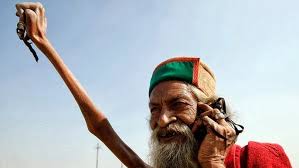In a world full of fleeting trends and shifting beliefs, the story of Amar Bharti stands out as a symbol of extraordinary human endurance, spiritual devotion, and physical sacrifice. A former clerk from New Delhi, Amar Bharti has kept his right arm raised above his head for over five decades — 52 years to be exact — as a tribute to the Hindu god Shiva and a call for world peace.
According to Indian media reports, this astonishing journey began in 1973 when Bharti, then an ordinary man leading a conventional life, decided to dedicate himself fully to a spiritual path. As a sign of devotion, he raised his right arm high in the air and vowed never to lower it again. That arm has remained suspended ever since.
At first, this act of spiritual commitment brought with it excruciating physical pain. Bharti reportedly endured intense suffering in the early years as his body tried to resist the unnatural posture. His muscles cramped, his joints stiffened, and the nerves in his arm began to deteriorate. Over time, due to the lack of circulation and use, his arm lost all sensation.
Eventually, medical experts say, the damage became permanent. His arm shrank, the muscles wasted away, and the hand withered. The cartilage in his shoulder and elbow — the flexible tissue that normally allows joints to move smoothly — has essentially disappeared. His arm is now fixed in place and cannot be moved without risking serious health consequences. Experts warn that forcing the arm down after so many years could result in severe injury, nerve shock, or even a life-threatening complication.
Despite the physical toll, Amar Bharti’s act is widely recognized in spiritual circles across India and beyond. To some, he is revered as a holy man who has made an unmatched sacrifice in the name of peace and religious devotion. To others, his story highlights the powerful impact of personal belief — as well as the extreme lengths to which people may go in pursuit of spiritual fulfillment.
However, the tale also raises important questions about health, tradition, and the human rights implications of such practices. In a society where customs and spiritual commitments are deeply rooted, Bharti’s case reflects a larger conversation in India around how far individuals can or should go in the name of belief.
Now in his later years, Amar Bharti remains an enduring figure of curiosity and inspiration. Pilgrims, tourists, and reporters continue to visit him, hoping to witness a living symbol of discipline and faith — a man whose raised hand has not wavered in over half a century. His story serves as a strange yet powerful reminder of the extremes to which the human body and spirit can be pushed when guided by deep conviction.


